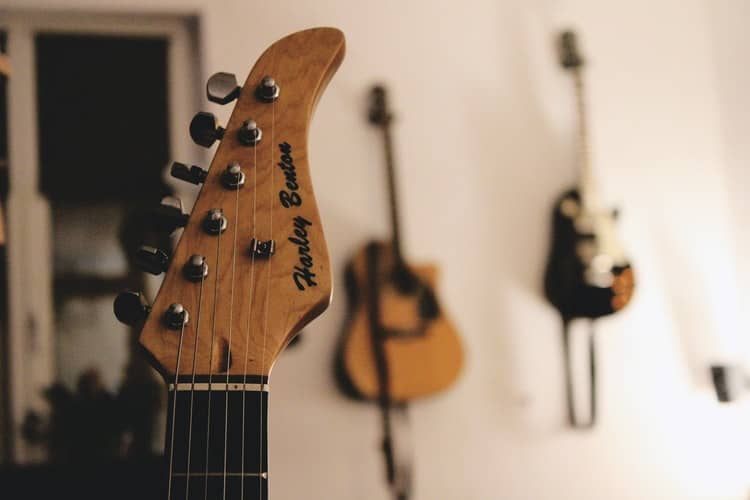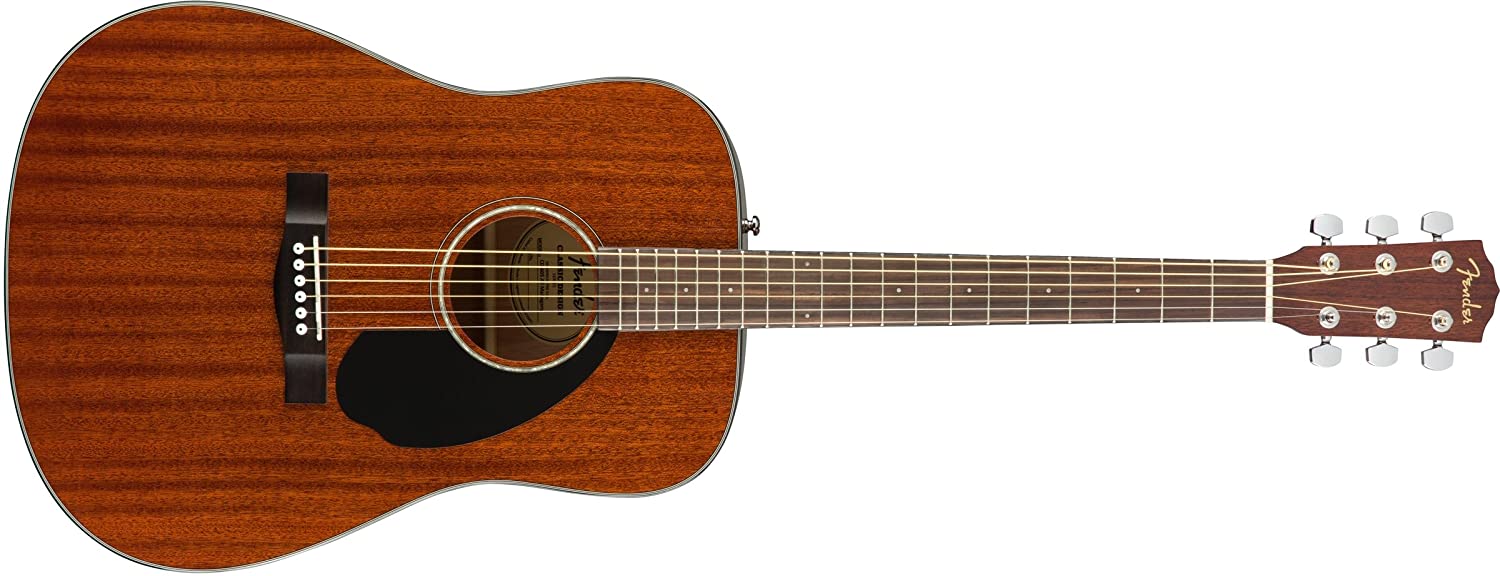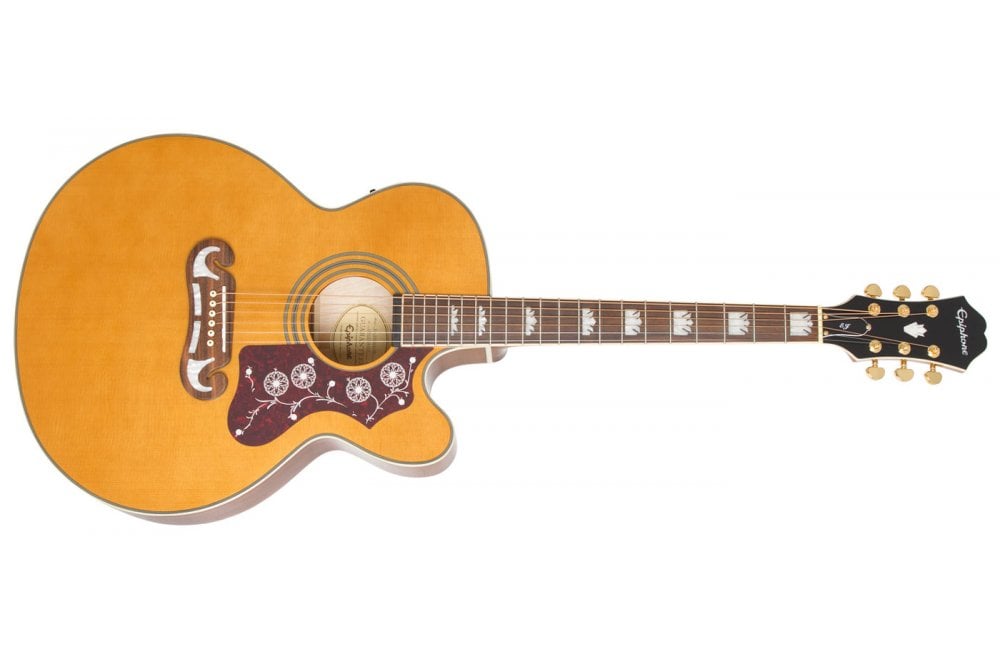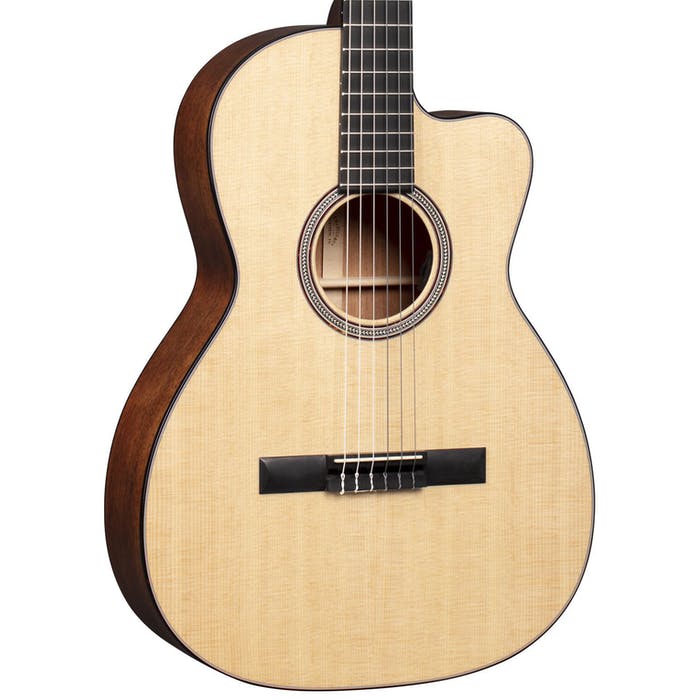Beginning guitarists who are doing the research before purchasing their first guitar will probably become confused when trying to make a decision between purchasing an acoustic guitar or a classical guitar.
It’s not uncommon to confuse these two instruments, especially because you can play the same genres and styles of music on each guitar. However, there are still differences between the two instruments and you should care about these differences.
Classical guitars are instruments that use nylon strings; classical guitars are commonly used in classical music. Yes, there are acoustic guitars, but to clarify the difference between classical and acoustic guitars, we identify classical guitars as classical.
On the other hand, acoustic guitars are guitars that use steel strings; acoustic guitars are more commonly found in today’s music compared to classical guitars. Most beginning guitarists tend to choose acoustic guitars over classical, but this decision often isn’t the best one to make for every beginning guitarist out there.
The differences between classical and acoustic guitars can be sound in how easy they are to play, the sound that they produce, how they are constructed, and what materials they are constructed from. At the end of this article, you will have a better understanding of the differences between a classical and an acoustic guitar are.
Let’s Discuss the Differences
When just glancing in the direction of a classical guitar and an acoustic guitar sitting right next to each other, the inexperienced guitarist will have a hard time spotting the difference. Classical guitars have an older design compared to acoustic guitars; as our technology and times have evolved, the appearance of instruments have changed to fit a faster production time.
If you are looking for a guitar that appears to look traditional, you’ll want to think about the classical guitar.
Some Other Differences Are:
The size of the bodies
Steel stringed acoustic guitars have larger-sized bodies and take up more space; that is if we’re not including parlor guitars. Parlor acoustic guitars have a similar size and shape to classical guitars.
Strings are another component that changes between classical guitars and acoustic guitars
Classical guitars use nylon strings and ONLY nylon strings; any other type of string puts too much tension on the neck and will warp the neck. Nylon strings produce a softer, more mellow sound, which plays a large role in the sound difference between classical and acoustic guitars.
Also, nylon strings are gentler on fingers compared to steel strings, which makes them great to use if you are a beginning guitar player. Acoustic guitars tend to use steel strings, which are a bit harder to play because they require more finger strength to manipulate.
Classical guitars have wider fingerboards that tend to be flatter; classical guitars also have a wider spacing for strings
Having this wide amount of space for your fingers makes playing a classical guitar more comfortable, especially if you have large hands. However, if you have smaller hands and fingers, you’ll have an easier time playing acoustic guitar.
Acoustic guitars with steel strings have strong, more solid bracing
This allows the guitar to have better resonance and projection. The better projection and resonance is caused by a high amount of tension of the strings, which is only found on acoustic guitars. Classical guitars have a lighter bracing, which means that this instrument does not project it’s sound as far as an acoustic guitar.
If you don’t know what a truss rod is, it is a steel rod that runs the entire length of the neck on all steel stringed instruments. Steel stringed instruments need the truss rods in order to reverse the amount of tension that the strings put on the neck. Nylon strings don’t put much tension on the neck and therefore, classical guitars don’t need truss rods.
Take a moment to look at where the neck and body fuse together
If there is a joint at the 14th fret, this is a newer guitar; however, if there is a joint at the 12th fret, this is an older guitar with a more classical guitar.
Classical guitars are also a lot cheaper compared to acoustic guitars
Hence, this is why a lot of beginning guitarists unknowingly tend to purchase classical guitars when making this first guitar purchase.
- Better to use for strumming
- Has a thinner neck
- Better to use for a wide variety of musical genres
- Has a larger and louder sound
- Has truss rod in the neck
- Metal/steel strings
- Has a solid headstock
- A lot of modern-day music is played on acoustic
- Produces immense volume
- Longer neck makes playing higher registers easy
- Steel strings are very heat resistant
- Don’t need to tune the strings often
- Since these are pieces of steel, you will need to apply a lot of pressure on the strings, which can be painful
- Brand new steel strings need frequent tuning
- Steel strings are larger than nylon strings, which can cause trouble for smaller players
- Nylon strings are very easy on the fingers
- Have smaller sized bodies
- Wide neck
- Does not come with a truss rod
- Produce a soft sound
- Nylon strings
- Has a cut-out headstock
- Produces a soft, mellow tone
- Really allows players to romanticize their music
- Has a gentle and mellow sound that’s perfect for Latin music, as well as many other genres
- Nylon strings don’t require callouses to add character to the music
- Easy to travel with
- If you’re looking to complete a lot of covers of today’s pop music, don’t purchase this guitar
- Lack volume and power
- Playing higher registers on the neck are difficult to do
- Nylon strings need consistent tuning
- Nylon strings are not heat or humidity resistant
The shape of the bodies serves as a subtle difference between the two instruments
Classical guitars do not come with a scratchplate, whereas acoustic guitars do. A scratchplate (also called a pickguard) is a piece of plastic that is placed right next to the soundhole to prevent a pick from scratching up the finish and body of an acoustic guitar.
Which Guitar Is Better for Beginners?

Whether you choose an acoustic guitar or a classical guitar, learning to play guitar is going to require a decent amount of work and at times, learning will become frustrating. However, starting out with the right type of guitar makes the learning process a lot easier.
A lot of beginning guitarists tend to quit playing because of the struggle learning the actual instrument, not the music.
Nylon strings (which are found on classical guitars) are very gentle on the fingers and make a great choice for children who are learning how to play. Acoustic guitars with steel strings are harder to play, but allow musicians to cover a larger genre of music. You can strum acoustic guitars with your fingers or with a pick, but you cannot strum classical guitars with a pick.
Classical guitars are mainly made for fingerpicking, as these guitars are mainly featured in flamenco music. You should solely base your decision on what types of music you would like to play and your musical goals, not by choosing which guitar is easier to play.
How Do I Choose My Guitar?
You should choose your guitar based upon your musical interest. Before you go and make any official purchases, you need to do some research about the guitar you’re interested in. If you are interested in playing fingerpicking style only or you are someone who has sensitive skin or sensitive fingers, I would personally suggest that you go with the classical guitar.
On the other hand, if you want to play a combination of strumming and fingerpicking, play a variety of music genres, and are looking for a louder sound from your instrument, you may end up preferring the steel stringed acoustic.
No matter what guitar you end up choosing, you’re going to need to adjust your guitar. Most guitars are sold in the box and are not taken out before shipping to be adjusted to ensure that playing the instrument is easy. Guitars that are mass produced all have a basic set up; the mass production of these instruments ensures that there the price tags are lower.
The lower price tags on these guitars means that there is not an extended period of time spent on each guitar to ensure that it’s easy to play as soon as you receive it. The more you practice, the more your fingers will get used to playing the string, whether it be nylon or steel strings.
The pain that strings cause doesn’t last a long period of time. When you first get your instrument, make sure that you gently start to tune the guitar. While at first, it may seem more comfortable to begin playing on unadjusted nylon guitar strings, they will actually bring you more pain over time. Adjusted guitar strings are the most comfortable strings to play on.
Acoustic Guitars
Steel stringed acoustic guitars tend to have a fingerboard that is more on the thinner side; steel stringed acoustics also typically tend to join at the 14th fret.
Here, I have a small list of a few fast facts about acoustic guitars that will make your shopping experience a bit easier:
- Better to use for strumming
- Has a thinner neck
- Better to use for a wide variety of musical genres
- Has a larger and louder sound
- Has truss rod in the neck
- Metal/steel strings
- Has a solid headstock
Acoustic guitars can also be referred as folk guitars, steel stringed guitars, acoustics, or dreadnaught guitars. You may hear an acoustic guitar be called these names and they mean all are referring to an acoustic guitar. The steel strings on an acoustic guitar allow the instrument to be able to play a whole span on musical genres, from rock, to soft rock, to blues, to country, folk, jazz, and many more genres.
If you are seriously looking to become a performing artist, you should own an acoustic guitar. You can always compose with the instrument and perform acoustic covers of any song you write with this instrument. If you’re looking to quickly build up your tolerance to the strings on a guitar, playing the acoustic guitar is a great way to do so.
The steel strings on the instrument allow players to quickly build up callouses; once you have callouses, playing any other type of guitar becomes incredibly easy. Acoustic guitars are also very popular in the music world, which makes finding them very easy to do!
Acoustic guitars come in a variety of different sizes and can be made for people of all heights, weights, shapes, and sizes. On top of that, Acoustic guitars can also be converted into different types of guitars, so the sizing of acoustic guitars are pretty inconsistent.
Pros of Steel Stringed Acoustics:
- A lot of modern day music is played on acoustic
- Produces immense volume
- Longer neck makes playing higher registers easy
- Steel strings are very heat resistant
- Don’t need to tune the strings often
Cons of Steel Stringed Acoustics:
- Since these are pieces of steel, you will need to apply a lot of pressure on the strings, which can be painful
- Brand new steel strings need frequent tuning
- Steel strings are larger than nylon strings, which can cause trouble for smaller players
Our Top Recommendations
Now, it’s time to introduce to you some of the best acoustic guitars on the market. If you’re ready to jump in and buy yourself your first acoustic guitar, there are some amazing models on the market. But, which acoustic guitars are worth your money? Well, let’s get into that!
But first, it’s important for you to know how I chose the acoustic guitars in this guide. First, I chose all of the guitars on this list based on the reputation of the guitar, the value for your money, and the overall playability of the instrument.
Without further hesitation, here are my top recommendations!
Fender CD-602 All Mahogany
If you’re looking for a budget-friendly guitar, I would highly recommend you check out the Fender CD-60S All-Mahogany guitar. It’s one of the best guitars on the market you can buy for only a couple hundred dollars. And if you’re afraid of buying a cheap guitar because you don’t want a cheaply made instrument, don’t worry!
The Fender CD-602 All Mahogany doesn’t play like a cheap guitar. Even when you pull it straight out of the box, the action isn’t too high and the sound is super bright.
Pros:
- Great neck profile, the perfect size for beginners
- Bright and warm tone
- The action isn’t high out of the box
- Super affordable
Cons:
- Doesn’t have a flawless finish
Epiphone J-200 EC Studio
On a budget, but still want something that’s better than a beginner guitar? The Epiphone J-200 EC Studio acoustic guitar is one of my favorite acoustic guitars for small acoustic performances. I love the stunning appearance of this guitar; the tortoiseshell pickguard is my favorite part of this guitar.
Even though this guitar is on the larger side, the sound is very well balanced. If you’re looking for an acoustic guitar upgrade to take with you while you do smaller performances (like a coffee shop), this would be perfect to play unplugged. But, it still keeps up with you when it’s plugged into an amp.
Pros:
- Beautiful finish
- Affordable buy for someone who isn’t a beginner
- Solid top
- Large and well-rounded sound
Cons:
- A bit on the larger size, may not be the best option for someone with a smaller body
Martin SC-13E
While this acoustic guitar does take a good chunk of change to invest in, it’s a brilliant instrument. If you’re upgrading for a cheaper guitar, you’ll notice the brilliant sound of this acoustic guitar and how amazing the balance of the instrument is. I’ve got a smaller body and smaller hands, but I didn’t find it difficult to hold and play this guitar. I love how Martin really focused on the ergonomics of this instrument.
But, that’s not all that this guitar has to offer either. Plus, there are Fishman MX-7 electronics installed in this guitar, with a sonicore pre-amp added in too. Whether you wanna play plugged in or unplugged, the Martin SC-13E will be there to back you up with whatever you need.
Pros:
- Beautiful balance
- High-quality eletronics
- Easy to hold
- Strikingly stunning guitar to look at
Cons:
- May be a bit too expensive for some people
Classical Guitars
It is a common misconception that playing the classical guitar will be easier because your fingers won’t have to do as much work compared to playing a steel-stringed acoustic guitar. However, it doesn’t matter which guitar you choose; as a beginner, your hands and fingers are going to need time to adjust to playing the instrument.
Classical guitars are commonly used in some types of pop music, jazz, folk, Latin music, and Brazilian music. It is very important for you to understand that if you are looking to produce a different sound from your instrument, you must NOT interchange strings. You cannot play nylon strings on an acoustic guitar and you absolutely cannot play steel strings on a classical guitar.
Nylon strings will need to be tuned more frequently than steel strings and that is because nylon strings are more sensitive to temperature and humidity changes. Steel strings are more stable than nylon strings and don’t need to be tuned as often. Despite this, both types of strings require frequent tuning to take care of your instrument and your strings.
Here, I have a small list of a few fast facts about acoustic guitars that will make your shopping experience a bit easier:
- Nylon strings are very easy on the fingers
- Have smaller sized bodies
- Wide neck
- Does not come with a truss rod
- Produce a soft sound
- Nylon strings
- Has a cut-out headstock
- Produces a soft, mellow tone
Nylon strings don’t work well with acoustic guitars because nylon strings don’t apply enough tension on the neck to produce a decent sound; nylon strings on acoustic guitars produce a sound that is too thin and weak. Nylon strings were designed to fit smaller sized guitars, thus if you place steel strings on a classical guitar, you will warp and break the neck on the instrument.
No matter your build, height, or age, classical guitars are an instrument that any person can learn and play on. Classical guitars are also a great instrument to learn on, because of the thickness of their necks; since these guitars have thick necks, players must be spot on with their technique.
Also, classical guitars tend to be a lot cheaper than acoustic guitars, but they are harder to find because they aren’t as commonly played. Classical guitars are very consistent in their sizing, as these types of guitars can never be changed into a type of steel guitar.
Pros of the Classical guitar:
- Really allows players to romanticize their music
- Has a gentle and mellow sound that’s perfect for Latin music, as well as many other genres
- Nylon strings don’t require callouses to add character to the music
- Easy to travel with
Cons of the Classical guitar:
- If you’re looking to complete a lot of covers of today’s pop music, don’t purchase this guitar
- Lack volume and power
- Playing higher registers on the neck are difficult to do
- Nylon strings need consistent tuning
- Nylon strings are not heat or humidity resistant
Read More: The Ultimate Yamaha C40 Classical Guitar Review You’ll Love
Our Top Recommendations
Are you ready to look at some of the best classical guitars on the market? Whether this is your first classical guitar purchase or you’re looking to upgrade the current classical guitar you own, it’s important for you to understand how I made the classical guitar recommendations I’ve listed below. I’ve chosen all of these guitars based on their playability, their reputation, and the true value you get out of each instrument.
Now, let’s take a look at each of my recommendations:
Yamaha C40II
This is a great guitar for someone who’s looking to get their hands on a good guitar, but doesn’t want to spend too much. Keep in mind that this guitar doesn’t have a lot of bells and whistles. However, this classic guitar proves that Yamaha is dedicated to always creating outstanding quality guitars.
The sound from this instrument is solid, but it’s super easy to play on. I personally would recommend this to anyone who’s thinking about starting out playing a classical guitar, but isn’t sure where to get started.
Pros:
- Not too pricey
- Great quality, which is normal from Yamaha
- A great guitar to use to transition to a classical instrument; it’s very easy to play
Cons:
- Doesn’t come with a lot of the extra perks an experienced player would be looking for
Martin 16 Series 000C12-16E
If you’re an experienced guitar player and you’re looking for an outstanding quality classical guitar, look no further than the Martin 16 Series 000C12-16E guitar. While the body of this guitar is small, it still has an amazing build. You’ll notice all of the attention to detail with this guitar if you’re experienced with instruments.
Pay attention to the cutaway on this guitar – it makes it super easy to access the upper frets for any solos you want to play. But, the most noticeable thing about this guitar is how rich and beautiful the tone is.
Pros:
- Natural and warm tone
- Super high-quality electronics
Cons:
- Smaller sized body, which may make it difficult for larger players to play
- Expensive
In Conclusion
Which guitar is the better choice for you? When making your decision between the two, the price point should not be your main focus, as they both are almost equal price-wise. You can purchase an inexpensive model of the classic guitar or an acoustic] for under $100 or you could invest in your musical career and spend thousands of dollars on a classical or an acoustic that will last you a lifetime.
You should base your purchase decision solely on what your musical interest is; if you want to play a lot of rock music, purchase yourself an acoustic guitar. Don’t feel pressured to choose a certain guitar because one is easier to play than the other; both guitars have their own pros and cons.
Every guitar or music store that you go to, they will let you test out instruments to help better make your decision. Take the time to play both a nylon-stringed guitar and a steel-stringed acoustic to see which one you like better.
- Best Black Friday / Cyber Monday Guitar Deals: Guitars, Amps, More! - November 27, 2023
- The Ultimate Yamaha C40 Classical Guitar Review You’ll Love - August 23, 2023
- The Best 12-String Guitars Guide - August 22, 2023









